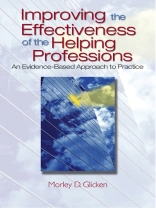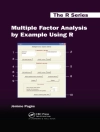The current practice of counseling, psychotherapy, and most helping professions often relies on clinical wisdom with little evidence of what actually works. Clinical wisdom is often a justification for beliefs and values that bond people together as professionals but often fails to serve clients since many of those beliefs and values may be comforting, but they may also be inherently incorrect.
Improving the Effectiveness of the Helping Professions: An Evidence-Based Approach to Practice covers the use of research and critical thinking to assist helping professionals make the most effective choices in treating clients with social and emotional problems. The use of evidence-based practice (EBP) comes at a time when managed care and concerns over health care costs coincide with growing concerns that psychotherapy, case management, and counseling may not be sufficiently effective ways of helping people in social and emotional difficulty.
Improving the Effectiveness of the Helping Professions provides an easy-to-read, inclusive approach covering EBP with posttraumatic stress disorder (PTSD) and terrorism, bereavement, substance abuse, mental illness, and problems experienced by older adults, among others. This text critically reviews the literature on self-help groups, religious involvement, and spirituality. It also includes sources to find best evidence, a simple overview of research concepts, a chapter on critical thinking, and numerous relevant case studies showing the application of EBP.
Improving the Effectiveness of the Helping Professions is ideally suited for undergraduate and graduate students in social work, psychology, counseling, criminal justice, psychiatric nursing, and psychiatry. This book should also prove beneficial to all practitioners and specialists in the helping professions.
Содержание
Acknowledgments & Preface
Part 1: THE CORE BELIEFS OF EVIDENCE-BASED PRACTICE
Chapter 1: An Explanation of Evidence-Based Practice
Definitions of EBP
Concerns About EBP From the Practice Community
Additional Criticisms of EBP With Responses
Is Evidence-Based Practice Applicable to the Helping Professions?
Summary
Integrative Questions
References
Chapter 2: A Simple Guide to Reading and Understanding Practice Research
Understanding the Scientific Method
A Few Important Issues to Consider When Reading Research
The Types of Research Studies
Quantitative (Empirical) Designs
Controlling for False Findings: Internal and External Validity
Internal Validity: Threats to Finding Cause-Effect Relationships
External Validity: Problems in Research That Limit Our Ability to Generalize Our Findings to Other Similar People, Situations, or Events
Sampling: A General Discussion
Sampling a Population Whose Members Are Known: Probability Sampling
Sampling a Population Whose Members Are Not Known: Nonprobability Sampling
Incorrect Conclusions
Reviews of Research That Yield Best Evidence
Applying Best Evidence to Practice
Summary
Integrative Questions
References
Chapter 3: The Importance of Critical Thinking in Evidence-Based Practice
Ways of Knowing
Mythologized Knowledge
Understanding the Logical Progressions in Research Ideas
Summary
Integrative Questions
References
Chapter 4: Locating Relevant Clinical Research
Useful and Not-So-Useful Sources
Evaluating the Quality of Articles Reviewed
Locating Relevant Research
Locating Evidence-Based Material on the Internet
Common Internet Sources
Summary
Integrative Questions
References
Part 2: HOW EBP VIEWS DIAGNOSIS, ASSESSMENT, AND WORKER- CLIENT RELATIONSHIPS
Chapter 5: Using Evidence-Based Practice in Diagnosis
Concerns About the Diagnostic Process
Reducing Errors in Diagnosis
The Adverse Impact of Labeling
Case Study: A Culturally Sensitive Diagnosis
Examples of EBP Diagnostic Data
Case Study: A Misdiagnosis
Highly Aggressive and Violent Young Children
Summary
Integrative Questions
References
Chapter 6: Evidence-Based Practice and Psychosocial Assessments
Case Study: Evidence-Based Practice and the Assessment Process
The Psychosocial Assessment Outline and the Relevant Information Pertaining to the Case
Summary
Integrative Questions
References
Chapter 7: Evidence-Based Practice and the Client-Worker Relationship: The Significance of the Therapeutic Relationship
Defining the Therapeutic Relationship
Evidence of the Importance of the Therapeutic Relationship to Treatment Outcomes
Gender and the Therapeutic Relationships
Racial and Ethnic Variables in Therapeutic Effectiveness
Case Study: A Positive Therapeutic Relationship
Summary
Integrative Questions
References
Part 3: EVIDENCE-BASED PRACTICE WITH SPECIAL CLIENT POPULATIONS
Chapter 8: Evidence-Based Practice Wth Cluster B Personality Disorders
The Four Types of Cluster B Personality Disorders
Developmental Theories Explaining Cluster B Personality Disorders
Treating Cluster B Personality Disorders: An Evidence-Based Practice Perspective
Case Study: EBP With a Borderline Personality-Disordered Client
Summary
Integrative Questions
References
Chapter 9: Evidence-Based Practice With Victims of Violence and Terrorism
Understanding the Link Between Trauma and the Development of Posttraumatic Stress Disorder
The Potential for Developing PTSD
The Prevalence of PTSD
The Impact of Recent Acts of Terrorism
Case Study: Adapting to a Terrorist Attack
Best Evidence of Effective Treatment for PTSD
The Recovery Process
Summary
Integrative Questions
References
Chapter 10: Evidence-Based Practice With Substance Abusers
Diagnostic Markers of Substance Abuse
Best Evidence for the Treatment of Substance Abuse
Case Study: A Brief Intervention After an Alcohol-Related Car Accident
Research Problems and Best Evidence
Summary
Integrative Questions
References
Chapter 11: Evidence-Based Practice With Mental Illness and Mood Disorders
The Extent and Impact of Mental Illness
Definitions of Mental Illness and Mood Disorders
Treatment Effectiveness Research
Case Study: Spontaneous Remission From Mental Illness
Summary
Integrative Questions
References
Chapter 12: Evidence-Based Practice With Terminal Illness and Bereavement
Terminal Illness
A Case Study: EBP With Terminal Illness
Bereavement
Case Study: EBP With Prolonged Grief
Summary
Integrative Questions
References
Chapter 13: Evidence-Based Practice With Anxiety and Depression in Older Adults
Anxiety in Older Adults
Best Evidence for the Treatment of Anxiety With an Older Adult Population
Case Study: Anxiety in an Older Client
Depression in Older Adults
Best Evidence for Treating Depression in Older Clients
Case Study: Depression in an Older Adult
Single-Subject Approaches to Evaluate Depression in Older Adults
A Goal Attainment Scale Measuring Improvement in Depression
How to Calculate the Overall Gain Made on a Goal Attainment Scale
Summary
Integrative Questions
References
Part 4: EVIDENCE-BASED PRACTICE AND ALTERNATIVE APPROACHES TO HELPING
Chapter 14: Evidence-Based Practice and the Significance of Religion and Spirituality
Definitions of Spirituality and Religious Involvement
The Impact of Spirituality and Religious Involvement on Physical and Mental Health
Case Study: A Client Using Religion to Cope With a Traumatic Childhood
Why Does Religious and Spiritual Involvement Impact Physical and Mental Health?
Should Issues of Religion and Spirituality Be Included in the Work of the Helping Professions?
Case Study: Religious Issues Discussed in Treatment
Problematic Research Issues
Summary
Integrative Questions
References
Chapter 15: Evidence-Based Practice and the Effectiveness of Indigenous Helpers and Self-Help Groups
Self-Help Groups
The Indigenous Leaders of Self-Help Groups
Case Study: An Indigenous Helper Starts a Self-Help Group
Best Evidence of the Effectiveness of Self-Help Groups
Q and A With the Author About the Meaning of These Studies
Case Study: Referral of a Client to a Self-Help Group for Severe Depression
Summary
Integrative Questions
References
Part 5: EVIDENCE-BASED PRACTICE AND FUTURE TRENDS, SOCIAL INVOLVEMENT, AND FINAL WORDS
Chapter 16: The Future of Psychotherapy
The Need for Practice Research
Alternative Ideas for Research on Treatment Efficacy
The Future of the Helping Professions
A Case Study: An Incompetent Worker Treats Chronic Depression
A Different Kind of Future: Workers Share Their Thoughts
Summary
Integrative Questions
References
Chapter 17: Some Final Words
Social Involvement
Avoiding Serious Practice Issues
Final Words
Summary
Integrative Questions
References
About the Author
Index
Об авторе
Dr. Morley D. Glicken is the former Dean of the Worden School of Social Service in San Antonio; the founding director of the Master of Social Work Department at California State University, San Bernardino; the past Director of the Master of Social Work Program at the University of Alabama; and the former Executive Director of Jewish Family Service of Greater Tucson. He has also held faculty positions in social work at the University of Kansas and Arizona State University. He currently teaches in the Department of Social Work at Arizona State University in Tempe, Arizona.Dr. Glicken received his BA degree in social work with a minor in psychology from the University of North Dakota and holds an Master of Social Work degree from the University of Washington and the Master of Public Administration and Doctor of Social Work degrees from the University of Utah. He is a member of Phi Kappa Phi Honorary Fraternity.In 2010, Praeger Press published his books on workaholism and retirement and another on mature love. In 2009, Praeger Press published his book A Simple Guide to Retirement (with Brian Haas). Elsevier, Inc. published his books Evidence-Based Practice with Troubled Children and Adolescents: A Psychosocial Perspective and, Evidence Based Counseling and Psychotherapy with an Aging Population, also in 2009. In 2008 he published A Guide to Writing for Human Service Professionals for Rowman and Littlefield Publishers. In 2006 he published Life Lessons from Resilient People, published by Sage Publications. He published Working with Troubled Men: A Practitioner’s Guide for Lawrence Erlbaum Publishers in 2005 and Improving the Effectiveness of the Helping Professions: An Evidence-Based Approach to Practice in 2004 for Sage Publications. In 2003 he published Violent Young Children, and Understanding and Using the Strengths Perspective for Allyn and Bacon/Longman Publishers. Dr. Glicken published two books for Allyn and Bacon/Longman Publishers in 2002: The Role of the Helping Professions in the Treatment of Victims and Perpetrators of Crime (with Dale Sechrest) and, A Simple Guide to Social Research.Dr Glicken has published over 50 articles in professional journals and has written extensively on personnel issues for Dow Jones, the publisher of the Wall Street Journal. He has held clinical social work licenses in Alabama and Kansas and is a member of the Academy of Certified Social Workers. He is currently Professor Emeritus in Social Work at California State University, San Bernardino and Executive Director of the Institute for Personal Growth: A Research, Treatment, and Training Institute in Prescott, Arizona offering consulting services in counseling, research, and management. More information about Dr. Glicken may be obtained on his website: www.morleyglicken.com. A listing of all of his books may be found on Amazon.com at: https://authorcentral.amazon.com/v/1973805540 and he can be contacted by email at: [email protected].












